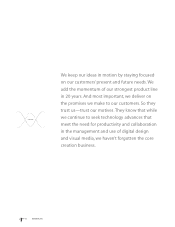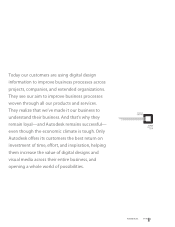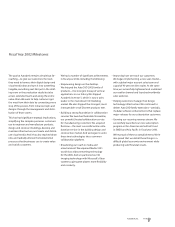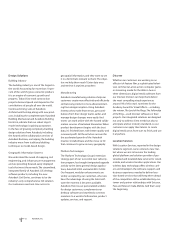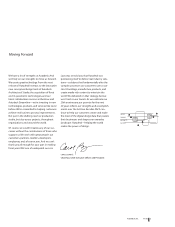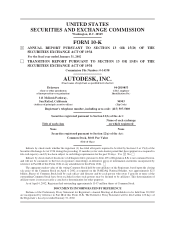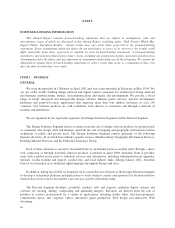Autodesk 2002 Annual Report Download - page 14
Download and view the complete annual report
Please find page 14 of the 2002 Autodesk annual report below. You can navigate through the pages in the report by either clicking on the pages listed below, or by using the keyword search tool below to find specific information within the annual report.The technology industry is characterized by rapid technological change in computer hardware, operating
systems and software, as well as changes in customer requirements and preferences. To keep pace with these
changes, we maintain an aggressive program of new product development to address demands in the marketplace
for increased connectivity and use of digital data created by our products. We dedicate considerable technical and
financial resources to research and development to further enhance our existing products and to create new
products and technologies. These investments may not result in sufficient revenue generation to justify their costs
or our competitors may introduce new products and services that will achieve acceptance among our current
customers, either of which may adversely affect our competitive position.
Our software products are complex and, despite extensive testing and quality control, may contain errors or
defects. These defects or errors could result in corrective releases to our software products, damage to our
reputation, loss of revenues, an increase in product returns or lack of market acceptance of our products, any of
which could harm our business.
We actively recruit and hire experienced software developers and license and acquire complementary
software technologies and businesses. In addition, we actively collaborate with and support independent software
developers who offer products that enhance and complement our products.
Independent firms and contractors perform some of our product development activities, while other
technologies are licensed from third parties. We generally either own or license the software developed by third
parties. Because talented development personnel are in high demand, independent developers, including those
who currently develop products for us, may not be able to provide development support to us in the future.
Similarly, we may not be able to obtain and renew existing license agreements on favorable terms, if at all, and
any failure to do so could harm our business.
Our business strategy has historically depended in part on our relationships with third-party developers, who
provide products that expand the functionality of our design software. Some developers may elect to support
other products or may experience disruption in product development and delivery cycles. In particular markets,
this disruption could negatively impact these third-party developers and end users, which could harm our
business.
MARKETING AND SALES
Our customer-related operations are divided into three geographic regions, the Americas, Europe and Asia/
Pacific, and are supported by global marketing and sales organizations. These organizations develop and manage
overall marketing and sales programs and work closely with a network of domestic and foreign offices. We sell
our software products both directly to customers, which include large corporations, and also through distributors
and resellers.
In addition, we work directly with reseller and distributor sales organizations, computer manufacturers,
other software developers and peripheral manufacturers in cooperative advertising, promotions and trade-show
presentations. We employ mass-marketing techniques such as webcasts, seminars, telemarketing, direct mailings
and advertising in business and trade journals. We have a worldwide user group organization dedicated to the
exchange of information related to the use of our products.
Our ability to effectively distribute our products depends in part upon the financial and business condition of
our reseller networks. Computer software dealers and distributors are typically not highly capitalized and have
previously experienced difficulties during times of economic contraction and may do so in the future. In addition,
the changing distribution models resulting from the Internet, from increased focus on direct sales to major
accounts or from two-tiered distribution may impact our reseller network in the future. While no single
13


